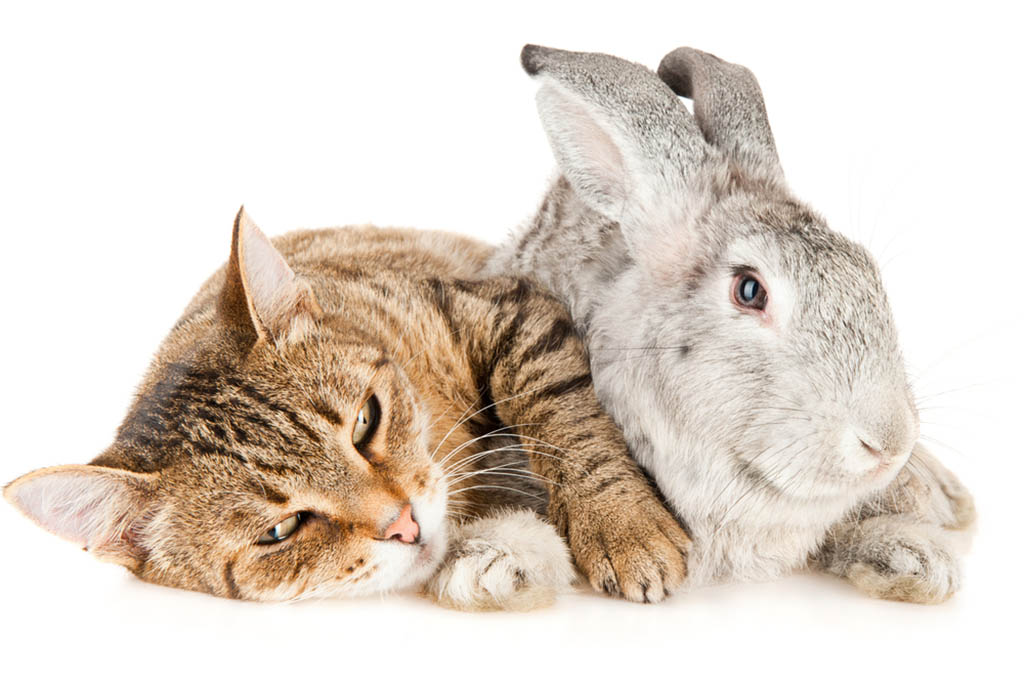Cats and rabbits can live together, but supervision and proper introduction are essential. Their compatibility depends on individual temperaments.
Cats and rabbits are popular pets, but their coexistence requires careful management. Proper introduction and supervision are crucial to ensure harmony. Cats have a natural hunting instinct, which can pose a threat to rabbits. On the other hand, rabbits can become stressed easily.
Creating a safe environment with separate spaces for each pet helps in reducing potential conflicts. Gradual introductions and positive reinforcement can foster a peaceful relationship. Always monitor their interactions initially to ensure safety. If done correctly, cats and rabbits can share a home and even form unique bonds. Understanding their needs is key to a successful cohabitation.

Credit: savvypetcare.com
Understanding Cat Behavior
Before introducing cats and rabbits, you must understand cat behavior. This can help you manage their interactions. Cats have unique behaviors that can affect their relationship with rabbits.
Predatory Instincts
Cats are natural hunters. Their predatory instincts are strong. They may see rabbits as prey. This is not because cats are mean. It is just their nature.
Watch your cat’s body language. If your cat crouches or stares, it may be preparing to pounce. Use barriers to keep them separate. Train your cat to be calm around the rabbit.
Social Dynamics
Cats have specific social dynamics. They may be territorial. They could see the rabbit as an intruder. This can cause stress for both animals.
- Introduce them slowly.
- Give each pet its own space.
- Use scent swapping to make them familiar with each other.
Ensure your cat has enough attention. A bored cat may act out. Provide toys and activities. This keeps your cat occupied and less interested in the rabbit.
| Behavior | Action |
|---|---|
| Stalking | Separate immediately |
| Hissing | Slow down introductions |
| Ignoring | Good sign, continue |
By understanding your cat’s behavior, you can make better decisions. This helps create a safe environment for both pets.

Credit: www.catsandrabbitsandmore.com
Understanding Rabbit Behavior
Before introducing cats and rabbits, it’s vital to understand rabbit behavior. Rabbits have unique traits. Knowing these can help ensure a peaceful coexistence.
Flight Response
Rabbits are prey animals. They have a strong flight response. This means they often run away from perceived threats. Sudden movements or loud noises can scare them. A frightened rabbit may hide or thump its feet. This behavior helps it alert others of danger.
Cats, being predators, might trigger this response. It’s crucial to create a calm environment. This helps the rabbit feel safe. Always introduce the cat slowly. Watch for signs of fear in the rabbit.
Territorial Nature
Rabbits can be very territorial. They mark their space with scent glands. This includes their living area and belongings. A cat entering this space can cause stress. The rabbit might become defensive or aggressive.
Set up separate areas for each pet. This reduces territorial disputes. Ensure each pet has its own food, water, and sleeping area. A shared space can be introduced gradually. Monitor interactions closely.
| Behavior | Explanation |
|---|---|
| Flight Response | Rabbits run from threats. They hide or thump feet. |
| Territorial Nature | Rabbits mark territory. They can get defensive. |
Initial Introductions
Introducing cats and rabbits requires patience and careful planning. The first meeting is crucial. It sets the tone for their future relationship. Proper steps can ensure a peaceful coexistence.
Neutral Territory
Introduce them in a neutral space. This is a place neither pet claims as their own. A neutral space reduces territorial aggression. Both pets feel less defensive.
Create a safe environment. Remove any sharp objects or potential hazards. Use a large room where both pets can move freely. Ensure there are hiding spots for both animals.
Observation And Supervision
Always supervise initial interactions. Never leave them alone during the first few meetings. Your presence ensures both pets feel secure.
Observe their body language. Signs of stress include flattened ears, growling, or hiding. If either pet shows stress, separate them immediately.
- Introduce them through a barrier like a baby gate.
- Allow them to see and smell each other safely.
- Gradually increase the time they spend together.
Use positive reinforcement. Reward calm behavior with treats and praise. This helps associate the other pet with positive experiences.
Introduce them for short periods. Gradually increase the duration as they become more comfortable.
By taking these steps, you can ensure a smooth introduction. This sets a solid foundation for their future interactions.
Creating A Safe Environment
Creating a safe environment for cats and rabbits is crucial. Both animals have different needs and behaviors. Ensuring their safety helps them live together peacefully.
Separate Spaces
Providing separate spaces is essential for both pets. Cats and rabbits need their own areas to feel secure.
- Designate specific rooms for each pet.
- Use pet gates to separate these areas.
- Ensure each space has food, water, and litter boxes.
This separation helps prevent conflicts and stress.
Escape Routes
Both animals must have escape routes. This ensures they can retreat if they feel threatened.
- Provide high perches for cats.
- Install hiding spots for rabbits.
- Ensure these routes are easily accessible.
Escape routes are vital for their mental well-being.
| Environment Feature | Cat Needs | Rabbit Needs |
|---|---|---|
| Resting Space | High perch, cozy bed | Quiet corner, soft bedding |
| Food Area | Separate bowls, high place | Ground level, away from cat’s area |
| Play Area | Scratching post, toys | Tunnels, chew toys |
Creating these features helps both pets thrive in the same home.
Building Trust
Creating a harmonious environment for cats and rabbits requires patience. Building trust is crucial. Both animals need to feel safe and comfortable. This process involves gradual interaction and positive reinforcement. Let’s explore these steps in detail.
Gradual Interaction
Start with separate spaces for your cat and rabbit. Allow them to get used to each other’s scent. Swap their bedding or toys for a few days. This helps them become familiar with each other’s smell.
Next, try visual introductions. Use a baby gate or a screen door. Let them see each other without direct contact. Observe their reactions closely. If they seem calm, it’s a good sign.
Once they are comfortable, proceed to supervised meetings. Always supervise these initial interactions. Keep the sessions short. Gradually increase the time they spend together. Ensure there is no aggressive behavior.
Positive Reinforcement
Use positive reinforcement to encourage good behavior. Reward both the cat and rabbit with treats when they are calm. This creates a positive association with each other’s presence.
Consistency is key. Keep interactions positive and rewarding. Avoid punishing either animal for negative behavior. This can create fear and distrust.
Provide interactive toys to keep them engaged. Toys that they can play with together can strengthen their bond. Puzzle feeders and treat-dispensing toys are excellent choices.
| Step | Action |
|---|---|
| 1 | Separate spaces |
| 2 | Swap bedding or toys |
| 3 | Visual introductions |
| 4 | Supervised meetings |
| 5 | Use positive reinforcement |
Following these steps helps in building trust between your cat and rabbit. Patience and consistency lead to a peaceful coexistence.
Signs Of Compatibility
Determining if cats and rabbits can live together depends on their compatibility. Observing their interactions provides clues. Understanding their body language and play behavior is key.
Body Language
Body language helps identify compatibility between cats and rabbits. Watch the cat’s tail and ears. A relaxed tail and forward ears indicate calmness. A twitching tail or flattened ears signal stress or aggression.
Observe the rabbit’s posture. A relaxed rabbit will lay down or hop around. If the rabbit thumps its hind legs or stays hunched, it feels threatened.
Look for mutual grooming. If they groom each other, it’s a good sign. This shows trust and affection between them.
Play Behavior
Play behavior reveals much about their relationship. Cats and rabbits play differently. Cats may swat or pounce, while rabbits hop and nibble.
Monitor their play sessions. Gentle interactions indicate compatibility. If the cat uses claws or the rabbit kicks aggressively, separate them.
Offer toys to both pets. See how they share or use them. Shared playtime without conflict shows positive interaction.
Use these signs to assess if your cat and rabbit can live together happily.
Long-term Coexistence
Can cats and rabbits live together for the long-term? The answer is yes, with proper care and attention. Long-term coexistence requires a few important steps to ensure both pets remain safe and happy. Establishing a routine and monitoring their health are crucial.
Routine And Consistency
Both cats and rabbits thrive on routine. Feeding them at the same time daily helps them feel secure. Set aside playtime for each pet. This keeps them active and engaged.
Maintain a consistent environment for both animals. Changes can cause stress. Ensure their living spaces are clean and free from hazards. A tidy space promotes a harmonious relationship.
Monitoring Health
Regular health checks for both pets are essential. Schedule vet visits to catch any health issues early. Watch for signs of stress or illness. Early detection can prevent serious problems.
Monitor their diet closely. Cats and rabbits have different nutritional needs. Ensure they receive the right food. Balanced diets contribute to their well-being.
By following these steps, cats and rabbits can live together peacefully. Routine and health monitoring are key to their long-term coexistence.
Credit: www.catsandrabbitsandmore.com
When Things Go Wrong
Sometimes, cats and rabbits do not get along well. Conflicts can arise, leading to stress for both pets. It’s important to handle these situations carefully.
Conflict Resolution
Understanding the reasons for conflict is crucial. Cats might see rabbits as prey. Rabbits can feel threatened by a cat’s presence.
Here are some steps to resolve conflicts:
- Separate the pets immediately to prevent injuries.
- Observe their behavior from a safe distance.
- Use positive reinforcement to reward calm behavior.
- Ensure each pet has its own space and resources.
Consider using a baby gate to separate the pets. This allows them to see and smell each other without direct contact. Gradually increase their time together under supervision.
Seeking Professional Help
If conflicts persist, seek professional help. A veterinarian can check for health issues causing aggressive behavior.
A pet behaviorist can provide specialized guidance. They can create a customized plan for your pets.
| Professional | Role |
|---|---|
| Veterinarian | Checks for health issues |
| Pet Behaviorist | Creates customized behavior plans |
Remember, patience and consistency are key. Resolving conflicts takes time.
Frequently Asked Questions
Can Cats And Rabbits Coexist Peacefully?
Yes, cats and rabbits can coexist. Introduce them slowly and monitor their interactions. Ensure both have safe spaces.
How To Introduce A Cat To A Rabbit?
Start with separate spaces. Gradually allow them to see each other. Always supervise initial interactions for safety.
Are Cats A Danger To Rabbits?
Cats can be a danger to rabbits. Always supervise their interactions to prevent harm. Provide safe spaces for the rabbit.
What Are Signs Of Stress In Rabbits Around Cats?
Signs of stress include hiding, thumping, or refusing to eat. Monitor their behavior closely when around cats.
Conclusion
Ensuring cats and rabbits live together peacefully requires patience and careful planning. Always prioritize their safety and comfort. Gradual introductions and supervised interactions are key. Remember, each pet has a unique personality. With proper care, they can coexist harmoniously, enriching your household with their unique charms.

